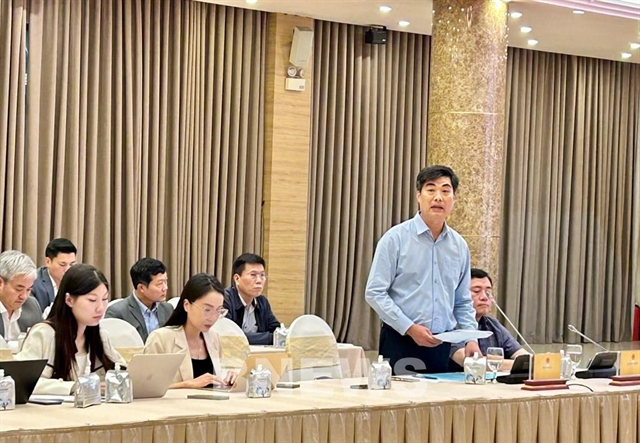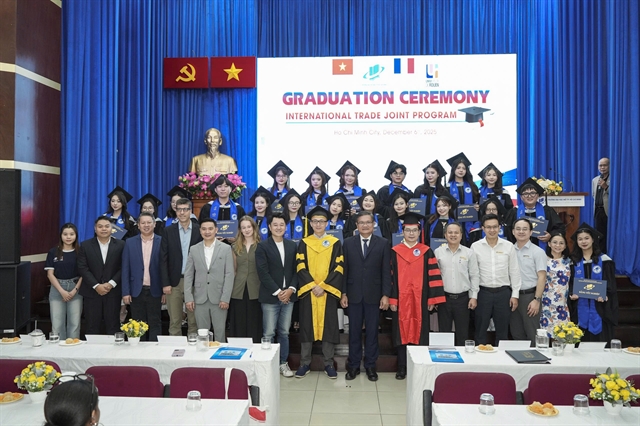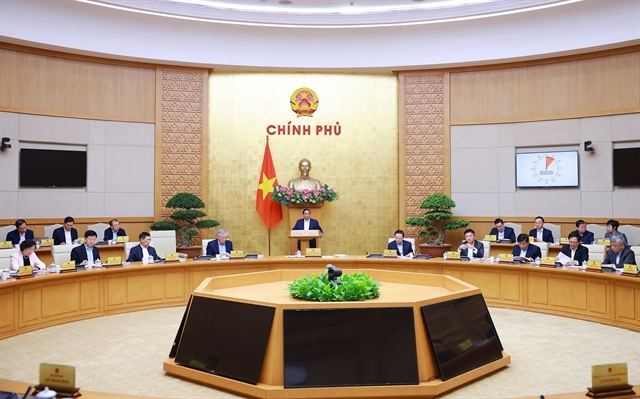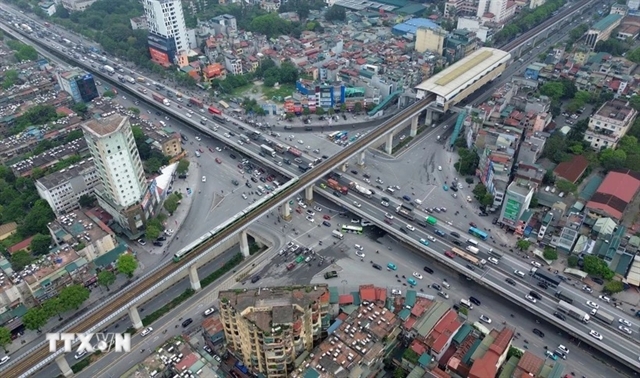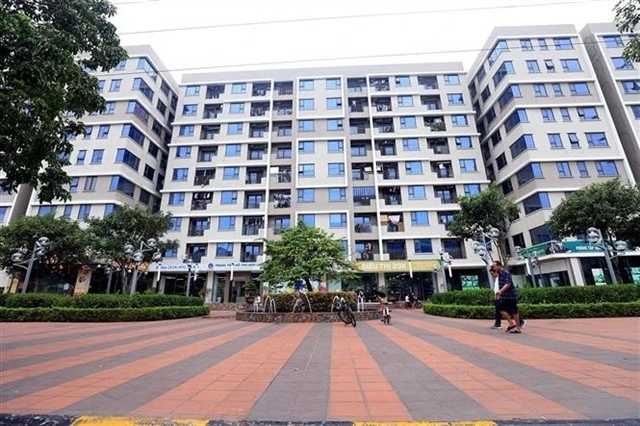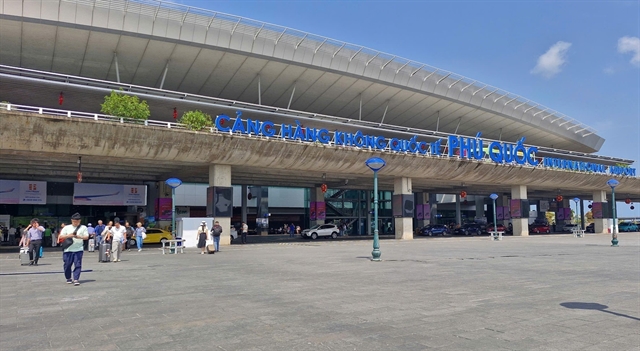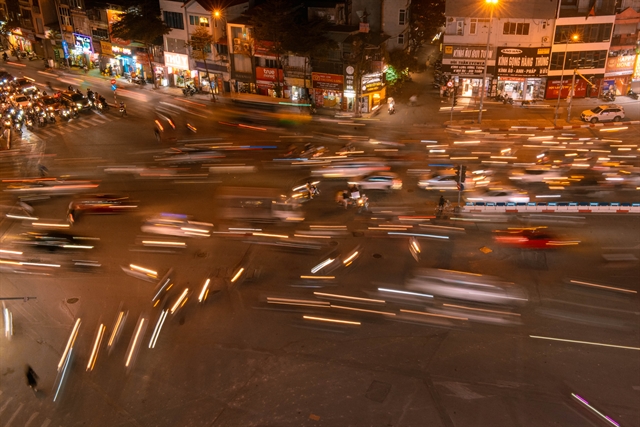
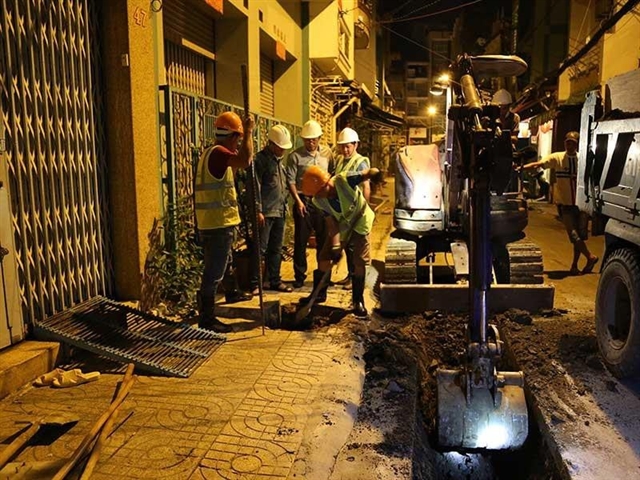 |
| Workers from EVNHCMC and VNPT carry out undergrounding of power lines and fibre-optic cables along Nguyễn Thới Trung Street in Quận 5 overnight to minimise traffic disruption and ensure timely project completion. VNA/VNS Photo |
HCM CITY — Beneath the bustling streets of HCM City, a silent transformation is taking place. As part of a long-term commitment to enhance the urban landscape and ensure public safety, the city is pushing forward with the ambitious undergrounding of power lines and telecommunications cables – a project that is both technically complex and emblematic of the city’s drive towards modernity.
Overhead wires, once an inevitable feature of the City’s skyline, have long been a source of concern for residents and city planners alike.
Tangled utility lines often present not only an aesthetic problem but also a safety hazard — especially during storms or when infrastructure deteriorates over time.
In the face of a rapidly urbanising population and rising demands on infrastructure, the city’s leaders have taken a resolute stance on eliminating this urban clutter.
A long-term vision taking root
The initiative to bury overhead cables began in earnest over a decade ago, driven by a shared determination among municipal authorities, public utility companies, and telecom providers.
Spearheaded by the HCM City People’s Committee, the project is being implemented in collaboration with HCM City Power Corporation (EVNHCMC), Viettel, VNPT, and other telecom enterprises.
According to EVNHCMC, between 2011 and 2021, the city successfully completed 93 projects that saw more than 370km of medium-voltage and low-voltage lines go underground.
These projects covered key central districts, including District 1, District 3, and parts of District 5, where overhead lines were once most densely concentrated.
Nguyễn Văn Thanh, Deputy Director of the Technical Department at EVNHCMC, noted that the programme is not merely about beautification.
“Undergrounding the power grid improves reliability, reduces maintenance costs in the long term, and enhances safety for residents,” he said. “It also facilitates better coordination among utilities by streamlining infrastructure.”
From 2021 to 2025, the city plans to implement a further 217 undergrounding projects, targeting an additional 500 kilometres of cable networks.
By 2030, the goal is to have most of the city centre and new urban areas such as Thủ Thiêm, Phú Mỹ Hưng, and the forthcoming Tân Sơn Nhất – Bình Chánh axis free of exposed wires.
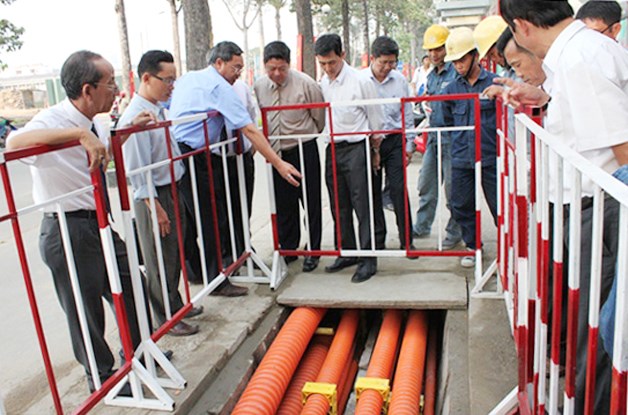 |
| Medium-voltage power lines and fibre-optic cables lay concealed beneath the carriageway, enhancing HCM City’s urban landscape and bolstering network reliability. VNA/VNS Photo |
From blueprint to reality: Technical and logistical hurdles
Despite the visible progress, the path to undergrounding the entire utility network is fraught with challenges.
The city’s dense urban layout, legacy infrastructure, and narrow roads pose considerable difficulties for construction crews. Digging up pavement, laying conduits, and reinstating the surface must all be done with minimal disruption to traffic, businesses, and daily life.
“Each street is unique,” said Phạm Minh Hùng, a project supervisor working on Nguyễn Đình Chiểu Street in District 3. “Some areas have old drainage systems or water pipes that were not clearly marked on maps. We often encounter unexpected obstacles underground.”
Moreover, coordinating among various stakeholders – electricity providers, telecom companies, and city agencies – is a time-consuming process.
Projects require meticulous planning to ensure that electricity cables, internet lines, and even future smart city components like surveillance or traffic systems can coexist within the same conduit networks.
To streamline implementation, HCM City has adopted a shared infrastructure model. Under this approach, joint trenches are constructed where power and telecom cables are laid side by side. This not only reduces the need for repeated excavation but also allows for easier maintenance and upgrades in the future.
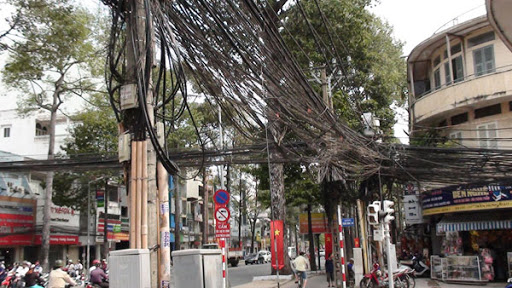 |
| A tangled web of overhead power and telecom cables before undergrounding, obstructing city vistas and posing safety risks to pedestrians. VNA/VNS Photo |
Financial considerations and public-private partnerships
Financing the undergrounding projects is another major concern. Estimates suggest that laying utility cables underground can cost five to seven times more than traditional overhead lines.
For instance, burying one kilometre of low-voltage cable might cost around VNĐ20–30 billion, depending on terrain and other conditions.
To alleviate the burden on public funds, the city is encouraging telecom companies to shoulder part of the investment cost, especially in areas where they directly benefit from improved service stability and aesthetics.
EVNHCMC, for its part, has proposed mechanisms for cost-sharing and longer investment cycles to ensure financial feasibility.
Public-private partnerships (PPP) are also gaining traction. In 2022, a pilot PPP project was launched in District 1 involving a collaboration between EVNHCMC, a consortium of telecom providers, and a private construction firm.
The success of the model has prompted the city to consider expanding it citywide.
“Shared investment is the way forward,” said Lê Thị Hòa, a planning officer at the HCM City Department of Construction. “The State cannot do this alone, but with private sector involvement, the process is faster and more efficient.”
Gains beyond aesthetics
For many residents, the benefits of underground cables go well beyond improved visual appearance.
During the rainy season, fallen electric poles and dangling wires are a constant source of anxiety.
Incidents of power outages, sparks, or even electric shocks in flood-prone areas have been reported over the years.
Since the implementation of underground cable networks in key areas, EVNHCMC has recorded a significant reduction in service interruptions. In District 1, where a majority of the grid has been buried, the number of power failures due to weather or technical faults dropped by more than 40 per cent between 2017 and 2023.
From a business perspective, uninterrupted power supply and stable internet are crucial for enterprises in finance, tourism, and IT services.
HCM City, being the country’s economic powerhouse, hosts thousands of businesses that depend heavily on digital connectivity and reliable infrastructure.
“Even an hour without power or internet can result in major losses,” said Trần Quang Long, manager of a hotel on Lý Tự Trọng Street. “Since the cables went underground here, we’ve seen a marked improvement in stability.”
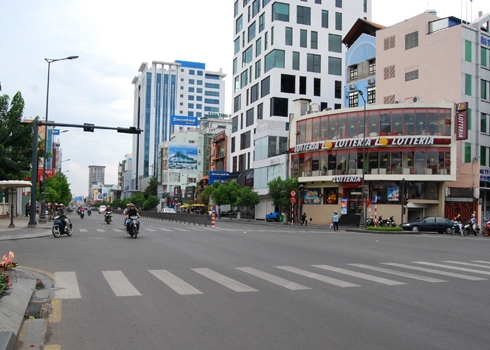 |
| Lý Thường Kiệt Street in District 10 enjoys a tranquil, uncluttered appearance after the completion of underground power lines and fibre-optic cables, offering a cleaner, greener public realm. VNA/VNS Photo |
Learning from other cities and looking ahead
The city is not alone in this transformation. Cities such as Hà Nội and Đà Nẵng are also implementing underground cable schemes, albeit at varying speeds.
Internationally, cities like Singapore, Tokyo, and Seoul have long completed the transition, offering useful lessons on financing models, regulatory coordination, and public engagement.
Taking cues from these global examples, HCM City is planning to integrate smart grid technologies into its buried infrastructure.
This includes sensor-based monitoring systems to detect faults in real time, remote-controlled circuit breakers, and infrastructure prepared for 5G rollout and future smart city applications.
The city also aims to revise outdated legal frameworks that currently slow down project approvals or delay coordination among different agencies.
The HCM City Department of Information and Communications is working on a centralised database to map all existing and planned cable networks, allowing for more effective planning and resource allocation.
The road ahead
Despite the progress and determination, officials are candid about the long journey ahead. As of 2024, only a small fraction of the city’s more than 5,000 kilometres of utility lines have been buried.
Outlying districts such as Bình Tân, Hóc Môn, and Củ Chi remain largely untouched by the programme due to logistical and financial constraints.
Nevertheless, the city is pushing forward with a sense of urgency. In late 2023, the People's Committee approved a plan to accelerate the process, setting yearly targets and assigning specific responsibilities to district-level authorities.
This decentralisation, it is hoped, will cut through bureaucracy and quicken implementation.
For residents like 65-year-old Lê Văn Đức, who has lived in District 5 since the 1970s, the change has been both welcome and overdue. “There used to be wires like cobwebs everywhere,” he said. “Now, when I look up, I can see the sky – it feels cleaner, safer, and more civilised.”
The buried cables may be out of sight, but their impact is increasingly felt across the city – in improved safety, better service reliability, and a more liveable urban environment.
HCM City is quite literally laying the groundwork for a smarter, safer, and more beautiful future. — VNS
